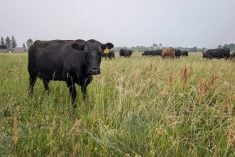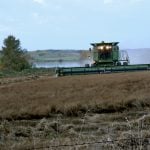Western Canadian feeder cattle values were steady to $2 per hundredweight (cwt) higher in comparison to two weeks earlier. Feedlot managers have a reserved attitude and the market can feel the cautious optimism for the fed market four to five months forward. Beef demand usually slows down during September and fed cattle were slightly softer in Alberta at $119/cwt.
Secondly, the bearish run on feed grains has subsided, given the recent heat wave in the U.S. Lethbridge-area barley traded at $205/cwt delivered feedlot last week and has stabilized for the time being. All these factors have cattle buyers hesitant to push the feeder market higher and the smaller to mid-size feedlot operator was notably lowering bids for replacement cattle.
Read Also

U.S. livestock: Cattle futures mixed
Cattle futures on the Chicago Mercantile Exchange were mixed on Thursday, after dropping sharply the previous session. The December live…
A small group of lighter silver yearlings with medium flesh averaging just over 700 pounds reached $159 delivered in the Lethbridge area. Yearling cattle of similar quality averaging 800 lbs. were trading near $150/cwt in the same region. Heifers in the 750-lb.-plus category continue to trade at a $10-$12/cwt discount to steers. The calf market was considered mixed and relatively undefined given the limited volumes of cattle under 700 lbs.
The Western Canadian yearling market has been trading at a discount to the U.S. by approximately $10/cwt and this spread should eventually narrow over the next month.
Equity markets appear to be softening and the beef complex appears to be factoring in a minor contraction in consumer spending during September and the first half of October. While boxed beef prices remain firm, September restaurant traffic is projected to be marginally lower in comparison to August.
Feedlot operators want to see higher prices for fed cattle before increasing bids on replacements. Look for the feeder market to trade sideways until U.S. corn production is more certain. Longer-term, the market has some favourable risks for higher prices but the nearby uncertainty of a softer fed cattle market and steady feed grain values has resulted in a cautious attitude amongst major feedlot operators.
— Jerry Klassen is a commodity market analyst in Winnipeg and maintains an interest in the family feedlot in southern Alberta. He writes an in-depth biweekly commentary, Canadian Feedlot and Cattle Market Analysis, for feedlot operators in Canada. He can be reached by email at [email protected] for questions or comments.
















